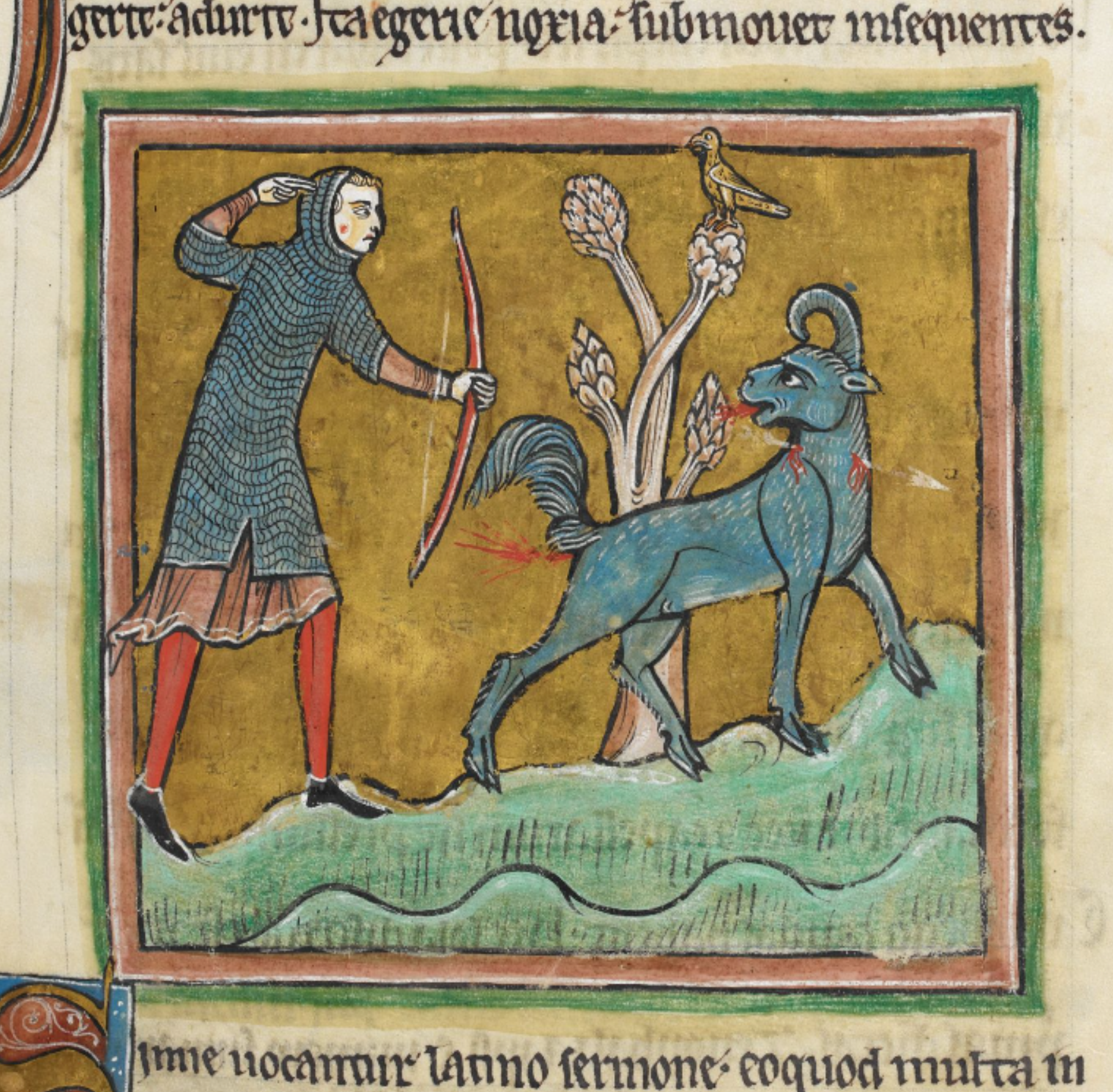Bonnacon, Rochester Bestiary, c.1230
The bonnacon1, also known as bŏnāsus or bonācus, was a mythical creature that had the body of a bull, the mane of a horse and inward-curving horns. The term comes from Greek βόνᾱσος/vónāsos meaning European bison. In Medieval Christianity, it might have represented deceit and illusion owing to its ability to discharge a noxious substance whilst fleeing. Allegorically, it could be a warning for Christians against the deceptive nature of worldly temptations and distractions leading the Faithful astray.
The animal’s ability to repel pursuers with its harmful excretion might be a symbol of repelling evil or warding off malevolent forces. In Christian symbolism, this might represent a call for the Faithful to resist and overcome the temptations posed by the devil.
rinum capud ac demceps2 corpus omne; iuba tantum equina;
Cornua autem ita multiplici flexu in se recurrentia;
ut si quis in eo offendat; non vulneretur. Sed quicquid pre-
sidii monstro illi frons negat; alvus sufficit; Nam cum
in fugam vertit; proluvie citi ventris fumum egerit; per
longitudinem trium iugerum. Cuius ardor quicquid atti-
gerit; adurit. Ita egerie noxia; submovet insequentes.
The bonnacon is an animal that originates in Asia. It has the head of a bull and thereafter the entire body of a bull, whereas only the mane is like that of a horse. Moreover, its horns are inward-curving and curl in towards each other, so that if anyone should collide with them, they would not be wounded. However, its belly provides this monster with some degree of protection, that which its forehead is not able to do. For instance, when it turns to flee, it discharges fumes from the swift movement of its bowels, covering the length of three acres, the heat whereof burns whatever it touches. Therefore, with its harmful excretion, it repels its pursuers.
Bibliography
David Badke, The Bestiary Blog: Animals in the Middle Ages, Bonnacon, November 6 2023, https://bestiary.ca/beasts/beast80.htm
Josh Goldenberg (BA 2012) and Matt Shanahan (BA 2014, Logeion, November 2022, https://logeion.uchicago.edu/
Castiglioni, L. and Mariotti, S. (1996). Vocabolario della Lingua Latina: Latino-Italiano Italiano-Latino. Terza Edizione. Loescher Torino
Matthews, J. and Matthews C., (2010), The Element Encyclopedia of Magical Creatures, HarperCollins UK, London
Curley, M. J., Physiologus: A Medieval Book of Nature Lore (University of Chicago edition 2009)
Rackham, H., M.A., Pliny Natural History Volume III, Libri VIII-XI (London: William Heinemann Ltd, 1949)
Collins, A. H., M.A., Symbolism of Animals and Birds (New York: McBride, Nast & Company, 1913)
Henderson, C., The Book of Barely Imagined Beings (London: University of Chicago Press, 2013)
White, T. H., The Bestiary: A Book of Beasts (New York: G.P Putnam’s Sons, 1960)
Barney, S. A., Lewis, W. J., Beach A., Berghof O., The Etymologies of Isidore of Seville (New York: Cambridge University Press, 2006)
Footnotes
1 Pliny the Elder mentioned this creature in his Natural History: “There are reports of a wild animal in Paeonia called the bonasus, which has the mane of a horse, but in all other respects resembles a bull; its horns are curved back in such a manner as to be of no use for fighting, and it is said that because of this it saves itself by running away, meanwhile emitting a trail of dung that sometimes covers a distance of as much as three furlongs (604 meters or 1,980 feet), contact with which scorches pursuers like a sort of fire."
2 Lithurgical Latin for dĕinceps = following, next/thereafter

